-
Product Name
JMJD7 Polyclonal Antibody
- Documents
-
Description
Polyclonal antibody to JMJD7
-
Tested applications
WB, IHC, IF
-
Species reactivity
Human, Mouse, Rat
-
Alternative names
JMJD7 antibody; jumonji domain containing 7 antibody
-
Isotype
Rabbit IgG
-
Preparation
Antigen: Recombinant fusion protein containing a sequence corresponding to amino acids 1-316 of human JMJD7 (NP_001108104.1).
-
Clonality
Polyclonal
-
Formulation
PBS with 0.02% sodium azide, 50% glycerol, pH7.3.
-
Storage instructions
Store at -20℃. Avoid freeze / thaw cycles.
-
Applications
WB 1:500 - 1:2000
IHC 1:50 - 1:200
IF 1:50 - 1:200 -
Validations
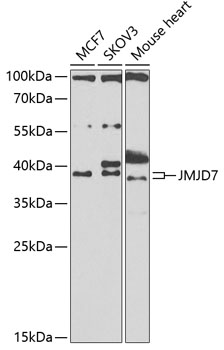
Western blot - JMJD7 Polyclonal Antibody
Western blot analysis of extracts of various cell lines, using JMJD7 antibody at 1:1000 dilution._Secondary antibody: HRP Goat Anti-Rabbit IgG (H+L) at 1:10000 dilution._Lysates/proteins: 25ug per lane._Blocking buffer: 3% nonfat dry milk in TBST._Detection: ECL Enhanced Kit ._Exposure time: 90s.
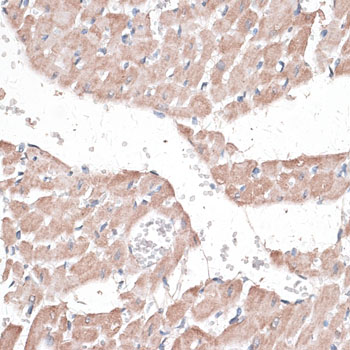
Immunohistochemistry - JMJD7 Polyclonal Antibody
Immunohistochemistry of paraffin-embedded rat heart using JMJD7 antibody at dilution of 1:100 (40x lens).
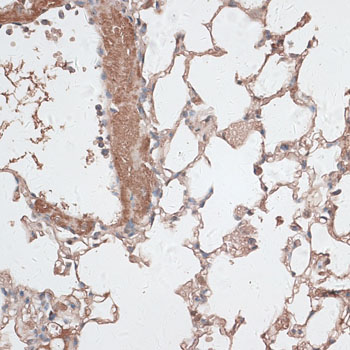
Immunohistochemistry - JMJD7 Polyclonal Antibody
Immunohistochemistry of paraffin-embedded mouse lung using JMJD7 antibody at dilution of 1:100 (40x lens).
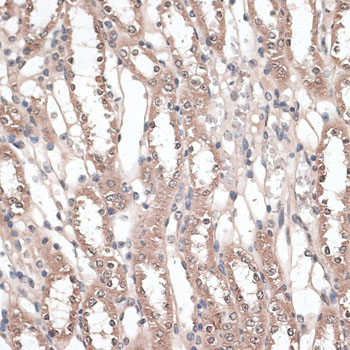
Immunohistochemistry - JMJD7 Polyclonal Antibody
Immunohistochemistry of paraffin-embedded mouse kidney using JMJD7 antibody at dilution of 1:100 (40x lens).
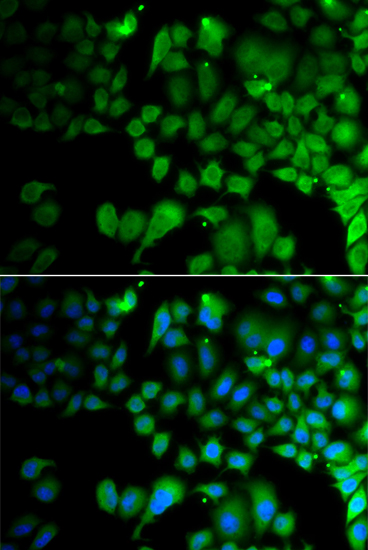
Immunofluorescence - JMJD7 Polyclonal Antibody
Immunofluorescence analysis of A549 cells using JMJD7 antibody . Blue: DAPI for nuclear staining.
-
Background
Bifunctional enzyme that acts both as an endopeptidase and 2-oxoglutarate-dependent monoxygenase. Endopeptidase that cleaves histones N-terminal tails at the carboxyl side of methylated arginine or lysine residues, to generate 'tailless nucleosomes', which may trigger transcription elongation. Preferentially recognizes and cleaves monomethylated and dimethylated arginine residues of histones H2, H3 and H4. After initial cleavage, continues to digest histones tails via its aminopeptidase activity. Additionally, may play a role in protein biosynthesis by modifying the translation machinery. Acts as Fe(2+) and 2-oxoglutarate-dependent monoxygenase, catalyzing (S)-stereospecific hydroxylation at C-3 of 'Lys-22' of DRG1 and 'Lys-21' of DRG2 translation factors (TRAFAC), promoting their interaction with ribonucleic acids (RNA).
Related Products / Services
Please note: All products are "FOR RESEARCH USE ONLY AND ARE NOT INTENDED FOR DIAGNOSTIC OR THERAPEUTIC USE"
